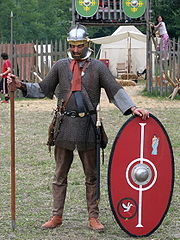
Lorica hamata
Encyclopedia

Chainmail
Mail is a type of armour consisting of small metal rings linked together in a pattern to form a mesh.-History:Mail was a highly successful type of armour and was used by nearly every metalworking culture....
armour used by the Roman Republic
Roman Republic
The Roman Republic was the period of the ancient Roman civilization where the government operated as a republic. It began with the overthrow of the Roman monarchy, traditionally dated around 508 BC, and its replacement by a government headed by two consuls, elected annually by the citizens and...
and the Roman Empire
Roman Empire
The Roman Empire was the post-Republican period of the ancient Roman civilization, characterised by an autocratic form of government and large territorial holdings in Europe and around the Mediterranean....
. During the 1st century it was starting to be supplemented by lorica segmentata
Lorica segmentata
The lōrīca segmentāta was a type of segmented armour almost exclusively used in the Roman Empire, but the Latin name was first used in the 16th century...
, but had been reintroduced as sole standard-issue armor by the 4th century. It was issued for both primary Legionary
Legionary
The Roman legionary was a professional soldier of the Roman army after the Marian reforms of 107 BC. Legionaries had to be Roman citizens under the age of 45. They enlisted in a legion for twenty-five years of service, a change from the early practice of enlisting only for a campaign...
and secondary Auxilia troops. They were mostly manufactured out of bronze
Bronze
Bronze is a metal alloy consisting primarily of copper, usually with tin as the main additive. It is hard and brittle, and it was particularly significant in antiquity, so much so that the Bronze Age was named after the metal...
or iron
Iron
Iron is a chemical element with the symbol Fe and atomic number 26. It is a metal in the first transition series. It is the most common element forming the planet Earth as a whole, forming much of Earth's outer and inner core. It is the fourth most common element in the Earth's crust...
. It alternated with rows of closed washer-like rings punched from iron sheets and riveted rings from drawn wire that ran horizontally, producing a very flexible, reliable and strong armour. Each ring had an inside diameter of about 5 mm, and an outside diameter of about 7 mm.
The shoulders of the lorica hamata had flaps that were similar to the Greek
Greece
Greece , officially the Hellenic Republic , and historically Hellas or the Republic of Greece in English, is a country in southeastern Europe....
'Linothorax
Linothorax
The linothorax was a type of upper body armor used by the Ancient Greeks, as well as other civilizations, from the Mycenaean Period through the Hellenistic Period. The earliest attested account of a linothorax used for battle is recorded in Book 2 of Homer's Iliad . It is worn by Ajax the lesser...
' which ran from about mid-back to the front of the torso, and were connected by brass or iron hooks which connected to studs riveted through the ends of the flaps. Up to 30,000 rings would have gone into one lorica hamata, and the estimated production time was two months even with continual slave labor at the state-run armouries.
The knowledge on the manufacturing of mail may have come from third century BC conflicts with the Celts, though the first documented use occurred during the Roman conquest of Hispania. There were several versions of this type of armour, specialized for different military duties such as skirmishers, cavalry and spearmen.
Although labor-intensive to manufacture, it is thought that, with good maintenance, they could be continually used for several decades. Constant friction kept the rings of the lorica hamata free of rust, unlike the segmentata which needed constant maintenance to prevent corrosion.
Over its lifetime, the Hamata remained in constant use by the legionaries and it was the preferred armour of the centurions, who favored its greater coverage and lower maintenance. The lorica hamata was still common amongst the Legionary soldiers in the 2nd century, despite the use of the more popularly recognized lorica segmentata
Lorica segmentata
The lōrīca segmentāta was a type of segmented armour almost exclusively used in the Roman Empire, but the Latin name was first used in the 16th century...
segmented plate armour. The segmentata was eventually discontinued in the third century for unknown reasons, but the lorica hamata remained common for both legionaries and auxilia. Later versions had sleeves and expanded to the knees unlike the earlier lorica hamata.

